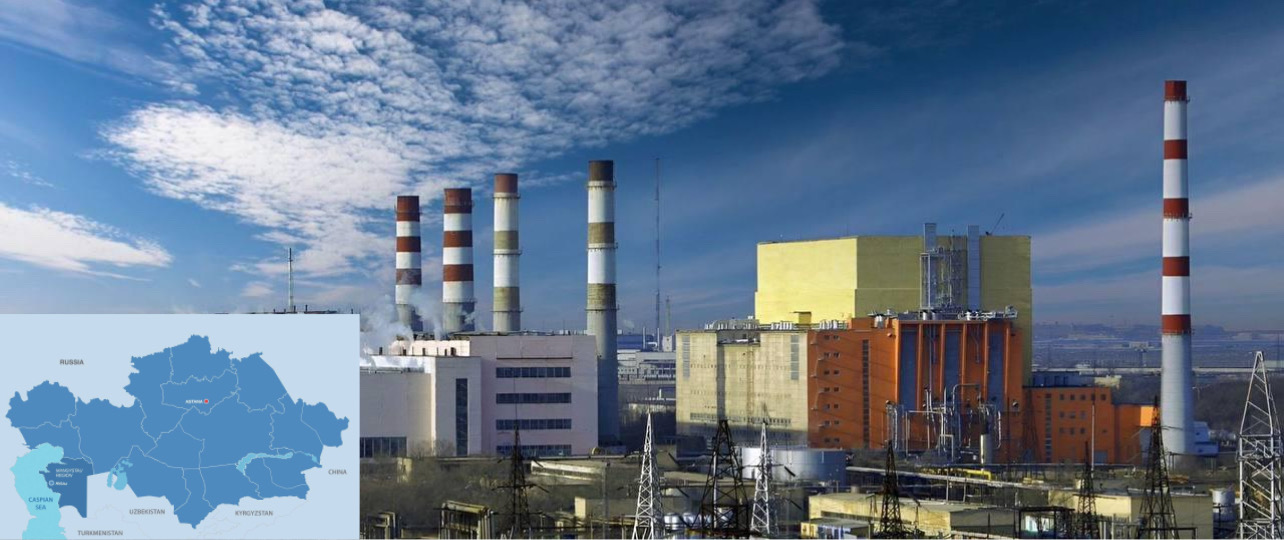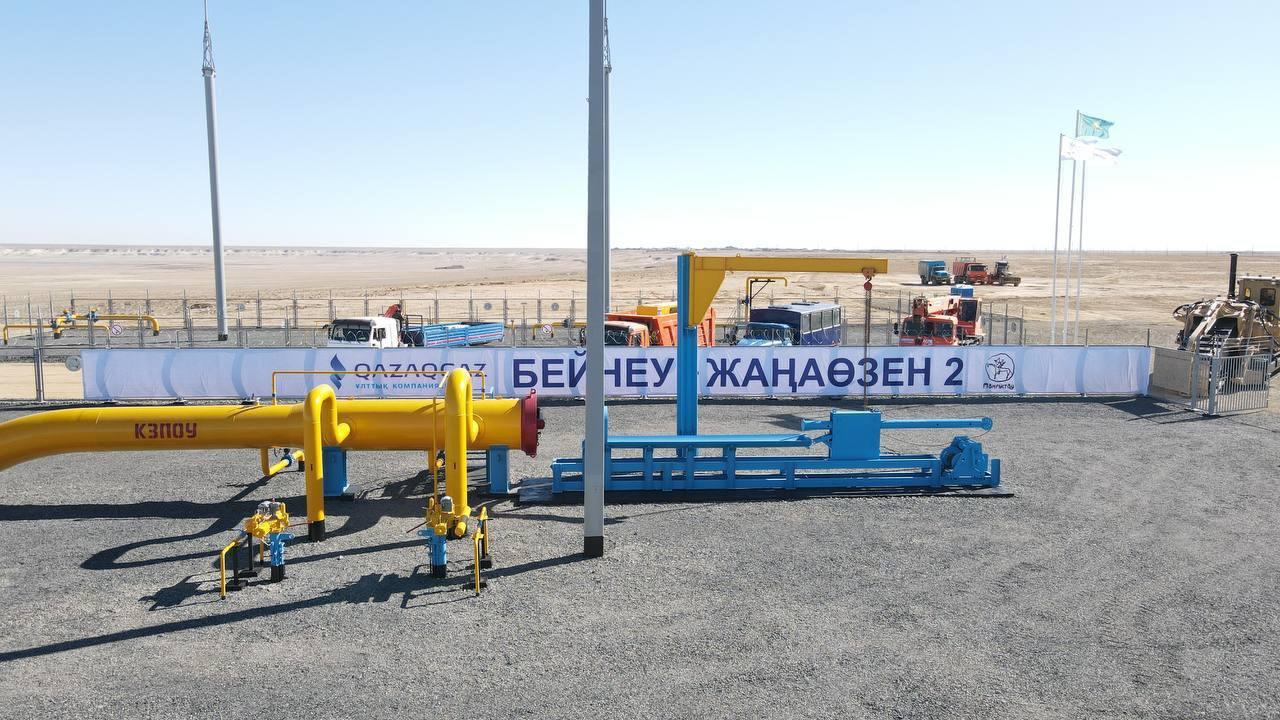ASTANA – Nurlan Nogayev, the akim (governor) of the Mangystau Region, discussed the pressing issues of the region and the corresponding measures to address them, including a detailed overview of the Mangystau Atomic Energy Complex (MAEC), during a Nov. 27 briefing, reported the press service of the akimat (governor’s office).

Photo credit: press service of the Mangystau Region’s Akimat. Click to see the map in full size. The map is designed by The Astana Times.
“The MAEC is confronted with a significant challenge. The shallowing of the Caspian Sea necessitates deepening existing water intake canals, posing a risk of water supply restrictions. To address this issue, plans include enhancing and deepening the MAEC’s water intake canals and constructing a water-receiving pipeline. Additionally, we aim to relocate the water intake pier to a deeper location, about five to six kilometers away,” explained Nogayev.
He further shared plans for the MAEC’s modernization, projecting an additional 130 megawatts at each thermal power plant.
“The Ministry of Energy oversees the construction of a 139-megawatt combined cycle gas turbine (CCGT), and the thermal power plant has three power units. Previously, the construction of a fourth unit for 230 megawatts was planned. The necessary infrastructure is in place, and we are addressing this matter. Considering all these measures, nearly 200 billion tenge ($434 million) is required to modernize and implement these projects,” he added.
Water supply challenges and infrastructure overhaul
Addressing communal infrastructure renovation and capacity expansion is a key focus in the region. Strategic initiatives target modernization across essential sectors like life support, engineering networks, and water supply. A crucial concern is the state of equipment at the MAEC, a vital enterprise, where the wear level of key mechanisms has reached 81%.

Photo credit: press service of the Mangystau Region’s Akimat.
Nogayev outlined a modernization program for MAEC, including key projects for constructing and upgrading equipment such as desalination, steam-gas, and turbo generators.
“This year, major repairs of turbo generators, boiler units, and auxiliary equipment are underway using the enterprise’s funds. The regional akimat has allocated 2.6 billion tenge ($5.6 million) to replace the most worn-out equipment, and another 4.9 billion tenge ($10 million) has been allocated for purchasing new equipment and components from the government’s reserve,” he said.
Reconstruction of engineering networks is a significant issue in Aktau. To provide quality communal services to the population by 2026, the modernization of 919 kilometers of engineering networks (water, sewage, heat) is planned in 25 micro-districts of the city, divided into five zones.
An essential aspect of infrastructure renewal is ensuring the region’s drinking water supply. The water deficit in the summer reaches 77,200 cubic meters per day. To address this, six water desalination projects with a total capacity of 136,000 cubic meters per day will be implemented by 2025.
The region is also constructing new desalination plants in various parts of the region to cope with water shortages. The second stage of bringing the Caspian desalination plant to 40,000 cubic meters is ongoing, with completion expected by April 2024.
In Aktau, construction is underway on a desalination plant funded by a private investor with a capacity of 20,000 cubic meters per day. The current installed equipment capacity is 3,600 cubic meters per day, with plans to double the capacity to 7,200 cubic meters per day by the end of the year.
Construction work on desalination plants in Fort Shevchenko for 5,000 cubic meters per day and in the Kenderli Region for 50,000 cubic meters per day has commenced this year.
Gas supply infrastructure expansion
The highest consumption of natural gas in Kazakhstan is in the Mangystau Region. Last year, the region accounted for 2.6 billion cubic meters, constituting 19% of the country’s domestic market demand.

Photo credit: press service of the Mangystau Region’s Akimat.
The gas supply through the second line of the Beineu-Zhanaozen main gas pipeline, extending 308 kilometers, was launched in October.
This initiative will ensure a stable gas supply to settlements and major industrial facilities, including MAEC, which generates thermal and electrical energy. The throughput capacity of the gas pipeline’s second line is 5.8 billion cubic meters per year. Previously, the Okarem-Beineu gas pipeline along this route provided slightly over three billion cubic meters of pumping. Now, the total throughput capacity of the two gas pipelines will reach nearly nine billion cubic meters per year, fully covering the region’s needs.
“The construction of the underground high-pressure gas pipeline, which connects the Kuryk village with the Sarsha area and the Warm Beach resort area near Aktau, has been completed. This project will provide gas to the Kuryk settlement and nearby industrial facilities and help the coastal areas develop their resort potential,” said Nogayev.
Under the Caspian Energy Hub initiative aimed at ensuring sustainable gas supply to new neighborhoods, a primary gas pipeline construction equipped with an automated gas distribution station is underway.
Originating from the Zhanaozen-Aktau pipeline, this 52-kilometer gas pipeline will provide heat and commercial gas to approximately 150,000 residents in emerging neighborhoods. The project is scheduled for completion by the year’s end, with the country earmarking 3.7 billion tenge ($7.9 million) for its realization.
Investments propel the region’s economic growth
Over the last five years, Mangystau has attracted more than three trillion tenge ($8 million) in investments, significantly propelling the region’s economic advancement. In the first ten months of the current year, investments totaling around 840 billion tenge ($1.8 billion) have been directed towards the primary capital, signifying a substantial 45% surge compared to last year.
In 2023, the region has initiated approximately 12 investment projects with a cumulative investment exceeding 11 billion tenge ($23 million). These projects encompass various sectors, including meat processing, metal production, specialized equipment manufacturing, reinforced concrete production, and antifreeze manufacturing.
Three additional projects, valued at nine billion tenge ($19 million), are slated for completion by year-end, creating approximately 90 new employment opportunities.
A pivotal venture includes the construction of a green hydrogen production plant by SVEVIND, a German-Swedish consortium. Encompassing a desalination facility, a renewable energy station, and a plant producing two million tons of green hydrogen, this project holds strategic importance.
“Additionally, the region is embarking on projects to fortify food security and bolster industrial and export potential. These include the construction of an ammonia-urea complex, a shipbuilding yard in the Caspian Sea, and the production of liquefied natural gas. These initiatives aim to enhance production capacities, foster related industries, and yield a multiplicative effect on the region’s socio-economic development,” said Nogayev.
Environment-friendly public transport
The region has introduced a new fleet of buses to improve the region’s ecology. Integral to this upgrade is a dispatch system allowing route tracking and video surveillance inside the buses. The region has operationalized its first methane gas station to supply fuel to these buses.
Nogayev emphasized that using gas engines in these new buses aligns with environmental goals, contributing to a reduction in harmful emissions.
“Our goal is to ensure safe, comfortable, and high-quality passenger transport services in the Mangystau Region, reduce the waiting time for buses, and offer the passenger transport market new high-quality buses,” stated Nogayev.
Tourism boost in the Mangystau Region
Over the past six months, the region has witnessed an influx of 180,000 tourists, including 16,000 foreigners.
Nogayev outlined ongoing efforts to enhance the tourism sector, including training, creating necessary conditions and infrastructure, and establishing visitor centers.
The region aims to implement 13 projects totaling 100 billion tenge ($217 million) by 2025. Additionally, two projects totaling 589 million tenge ($1.2 million) have been launched this year, including the construction of the Caspi Life recreation base and Eco-Otel hotel.


